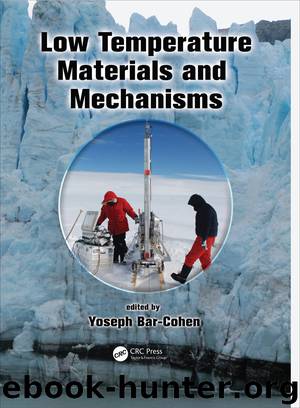Low Temperature Materials and Mechanisms by Yoseph Bar - Cohen

Author:Yoseph Bar - Cohen
Language: eng
Format: epub
Publisher: CRC Press, Taylor & Francis Group
Published: 2016-03-15T00:00:00+00:00
9.3.2.1 Sampling Lakes and Seas on Titan
Exploration of Titan’s lakes and seas, thought to be composed primarily of methane and ethane, represents a primary science goal for Titan and Outer Planet science. Titan lake and sea landers have been studied as a potential element in the Titan Saturn System Mission [ESA, 2009], as a stand-alone mission concept [Vision and Voyages, 2011], the Discovery 12 Step 2 mission concept Titan Mare Explorer (TiME) [Stofan et al., 2013], as well as exploration concepts described earlier. Primary science goals for measurements of the Titan seas include the determination of the chemical make-up of the liquid with the isotopic compositions of major elements, the inventory of dissolved gases, and the identification of trace molecules and suspended solids that result from the active CH4 photochemical cycle. Furthermore, the lakes in the South Pole in particular may exhibit seasonality [Hayes et al., 2011], and so a temporal investigation of the composition over the long (~7.5 yr/season) seasonal cycle on Titan would be desirable.
Mass spectrometry, as a “universal” detector, is likely to play a major role in future in situ investigations of the Titan lakes. We therefore frame this discussion using mass spectrometry as a strawman analyzer to facilitate the following discussion of sampling from a cryogenic liquid. The primary challenges for sampling the lakes for compositional analysis are as follows: (1) the sampling mechanism must function in the cryogenic fluid at approximately 90 K; and (2) the acquired liquid sample must be converted into gas and transferred to the ion source of the mass spectrometer, with the conversion of the sample to the gas phase preserving the integrity of the sample to ensure proper quantitative analysis. This must be accomplished despite a wide array of unknowns, such as the bulk composition, which drives the range of boiling points and specific heats, as well as the particulate load and sizes and the liquid viscosity (Lorenz et al., 2010).
The challenge of developing a sampling system that is compatible with the cryogenic fluids may be the most straightforward to address. The propulsion, medicine, food, and aerospace industries have developed cryogenic fluid management technologies that operate well within the conditions of the Titan seas. Valves that function at the cryogenic temperatures are commonly designed to operate with LN2 (77 K), LO2 (55 K), or LHe (4 K). NASA has led efforts to advance cryocooler technologies using LHe in support of Earth and Space Science Missions, with a recent push for the James Webb Space Telescope instrumentation. Given the mass, power, and volume constraint of planetary instruments, miniaturized automated valves designed for other spaceflight applications will be necessary components for in situ fluid sampling on Titan. Materials typically used in cryogenic valves, metals (e.g., stainless steel, copper, brass, aluminum and its alloys) and plastics (Teflon®, Vespel®, Torlon®), should be robust in the hydrocarbon liquids, which are not particularly corrosive. However, any proposed valve system would need to be tested against relevant mixtures for possible degradation of mechanisms or valve seats.
Cryogenic seals
Download
This site does not store any files on its server. We only index and link to content provided by other sites. Please contact the content providers to delete copyright contents if any and email us, we'll remove relevant links or contents immediately.
| Biochemistry | Biomedical Engineering |
| Biotechnology |
Whiskies Galore by Ian Buxton(40623)
Introduction to Aircraft Design (Cambridge Aerospace Series) by John P. Fielding(32367)
Small Unmanned Fixed-wing Aircraft Design by Andrew J. Keane Andras Sobester James P. Scanlan & András Sóbester & James P. Scanlan(32155)
Craft Beer for the Homebrewer by Michael Agnew(17472)
Turbulence by E. J. Noyes(7078)
The Complete Stick Figure Physics Tutorials by Allen Sarah(6657)
Kaplan MCAT General Chemistry Review by Kaplan(6083)
The Thirst by Nesbo Jo(5815)
Bad Blood by John Carreyrou(5798)
Learning SQL by Alan Beaulieu(5445)
Weapons of Math Destruction by Cathy O'Neil(5068)
Man-made Catastrophes and Risk Information Concealment by Dmitry Chernov & Didier Sornette(4773)
iGen by Jean M. Twenge(4714)
Digital Minimalism by Cal Newport;(4605)
Life 3.0: Being Human in the Age of Artificial Intelligence by Tegmark Max(4534)
Audition by Ryu Murakami(4122)
Electronic Devices & Circuits by Jacob Millman & Christos C. Halkias(4061)
1,001 ASVAB Practice Questions For Dummies by Powers Rod(4055)
Pale Blue Dot by Carl Sagan(4031)
